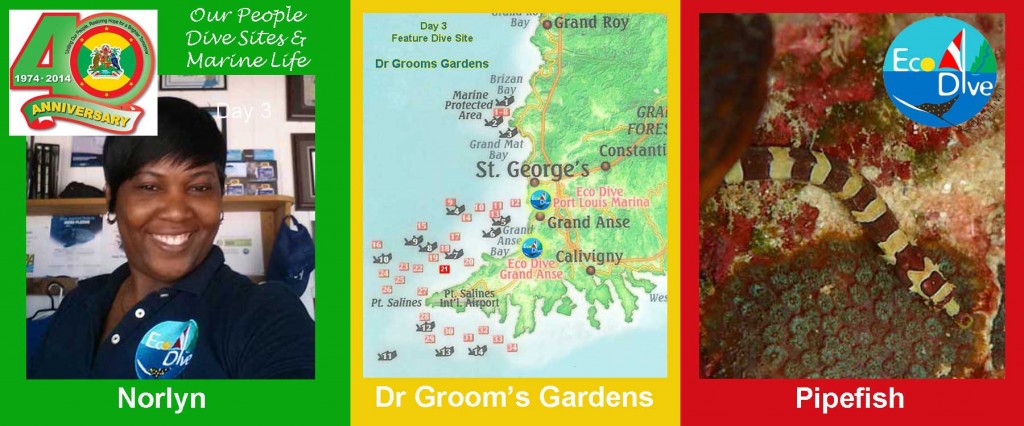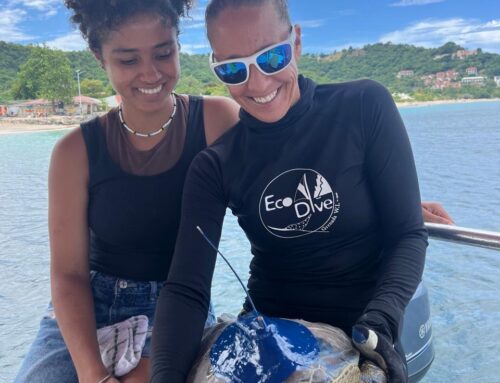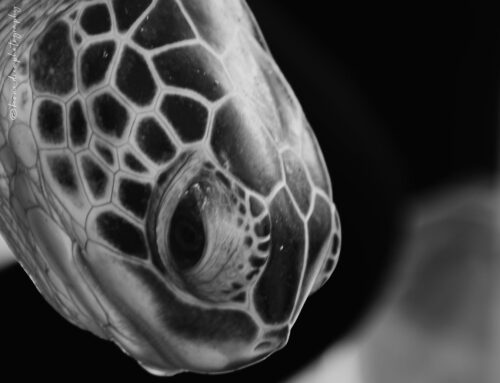Our People – Norlyn, Office Manager
Norlyn has been the friendly front office face of Eco Dive for more than 10 years and all of our guests will be sure to ‘meet’ her either by email, over the phone or here in person. A busy mother of two and now a diver in training Norlyn helps Eco Dive in countless ways keeping us all on track and our scuba divers’ and snorkelers’ schedules organized. We are proud to have her on our team and definitely happy to have her as one of our feature people during this 40th independence celebration. Looking forward to that PADI Scuba Diver certification and we all know there are a good number of our repeat guests that look forward to seeing Norlyn on a dive!
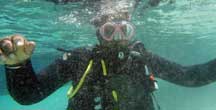
Dive Site – Dr Groom’s Gardens
Dive profile 30’/10m – 50’/14 m
Off of Dr Grooms Beach along the south west corner of Grenada this site is a shallow reef dive starting in just 30 feet of water between sand channels and reef outcroppings. A great place for photography and critter hunting the contrast between white sand and patch reef provides ample opportunity for divers to get down and personal with the reef without touching or doing any harm. The fringe areas can be best for spotting some of our more shy or well camouflaged critters and the intermingled soft corals and sea fans provide a beautiful landscape view of the reef. With typically light currents and the occasional strong drift this site is ideal for a nice an easy Caribbean reef dive.
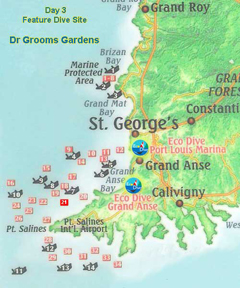
Feature Creature – Pipefish (Syngnathidae)
Pipefish are a small group of fish from within the family Syngnathidae, meaning ‘jaw fused.’ A first cousin of the most well known member of this family, the Seahorse, in total the Pipefish family contains four subfamilies and over 320 species different species.
All Syngnathids possess an elongated semi-flexible body with armored, bony plates. They do not possess scales. Gill openings are usually reduced to a small round pore, and the head is generally long and tubular. The jaws are fused, resulting in a structure without a hinge to open and close, this impacts their dietary preferences and as a result Pipefish feed via suction and are limited to whatever organisms fit. The majority of their diet is comprised of tiny crustaceans that swim near the bottom however they will also filter feed larvae and small organisms from the water column. Interestingly foods that do not fit into their fixed jaws are often “de-gutted,” (they suck the abdomen out of the food item, and let the skeleton go).
Pipefish are secretive fish found primarily in shallow water (<30 m) and they usually associate with overhangs or crevices within the rock/coral framework. With little means for defense an escape route back into the rock or reef is their best bet when avoiding predators. Like seahorses the males hold the fertilised eggs during development, typically for pipefish this is 100-200 eggs at a time, but can be as many as 1000 eggs species and individual dependent. At hatching the fry are released into the water column travel with the currents and settle relatively quickly back down to the seafloor. For more information on the pipefish see HERE
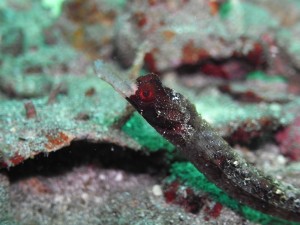 A white nosed Pipefish seen in Flamingo Bay. Picture taken by GT. Title Pipefish picture of the Harlequin Pipefish taken by Jenn O.
A white nosed Pipefish seen in Flamingo Bay. Picture taken by GT. Title Pipefish picture of the Harlequin Pipefish taken by Jenn O.

